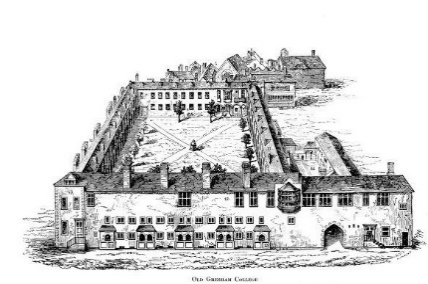22 MAKING CONNECTIONS BETWEEN IDEAS: The Scientific Revolution
The scientific revolution, which emphasized systematic experimentation as the most valid research method, resulted in developments in mathematics, physics, astronomy, biology, and chemistry.
|
Watch and Learn |
|
Watch John Green explain the Scientific Revolution (Crash Course in European History #12) |
The Scientific Revolution
The scientific revolution was the emergence of modern science during the early modern period, when developments in mathematics, physics, astronomy, biology (including human anatomy), and chemistry transformed societal views about nature. The scientific revolution began in Europe toward the end of the Renaissance period, and continued through the late 18th century, influencing the intellectual social movement known as the Enlightenment. While its dates are disputed, the publication in 1543 of Nicolaus Copernicus ‘s De revolutionibus orbium coelestium (On the Revolutions of the Heavenly Spheres) is often cited as marking the beginning of the scientific revolution.
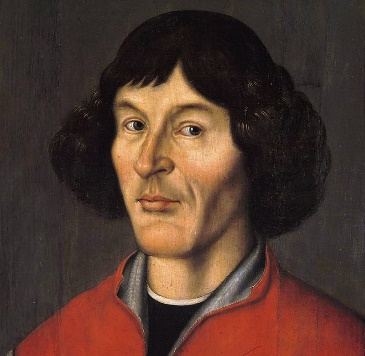
A portrait of Nicolaus Copernicus, 1580. (Source: Wikimedia)
The scientific revolution was built upon the foundation of ancient Greek learning and science in the Middle Ages, as it had been elaborated and further developed by Roman/Byzantine science and medieval Islamic science. The Aristotelian tradition was still an important intellectual framework in the 17th century, although by that time natural philosophers had moved away from much of it. Key scientific ideas dating back to classical antiquity had changed drastically over the years, and in many cases been discredited. The ideas that remained (for example, Aristotle ‘s cosmology, which placed the Earth at the center of a spherical hierarchic cosmos, or the Ptolemaic model of planetary motion) were transformed fundamentally during the scientific revolution.
The change to the medieval idea of science occurred for four reasons:
- Seventeenth century scientists and philosophers were able to collaborate with members of the mathematical and astronomical communities to effect advances in all fields.
- Scientists realized the inadequacy of medieval experimental methods for their work and (out of necessity) devised new methods of observation and evaluation.
- Academics had access to a legacy of European, Greek, and Middle Eastern scientific philosophy that they could use as a starting point (either by disproving or building on the theorems).
- Institutions (for example, the British Royal Society) helped validate science as a field by providing an outlet for the publication of scientists’ work.
A drawing of Gresham College where members of the British Royal Society met. (Source: Wikimedia)
New Methods
Under the scientific method that was defined and applied in the 17th century, natural and artificial circumstances were abandoned, and a research tradition of systematic experimentation was slowly accepted throughout the scientific community. The philosophy of using an inductive approach to nature (to abandon assumption and to attempt to simply observe with an open mind) was in strict contrast with the earlier, Aristotelian approach of deduction, by which analysis of known facts produced further understanding. In practice, many scientists and philosophers believed that a healthy mix of both was needed—the willingness to both question assumptions, and to interpret observations assumed to have some degree of validity.
During the scientific revolution, changing perceptions about the role of the scientist in respect to nature, the value of evidence, experimental or observed, led towards a scientific methodology in which empiricism played a large, but not absolute, role. The term British empiricism came into use to describe philosophical differences perceived between two of its founders—Francis Bacon, described as empiricist, and René Descartes, who was described as a rationalist. Bacon’s works established and popularized inductive methodologies for scientific inquiry, often called the Baconian method, or sometimes simply the scientific method. His demand for a planned procedure of investigating all things natural marked a new turn in the rhetorical and theoretical framework for science, much of which still surrounds conceptions of proper methodology today. Correspondingly, Descartes distinguished between the knowledge that could be attained by reason alone (rationalist approach), as, for example, in mathematics, and the knowledge that required experience of the world, as in physics.

Francis Bacon was a pivotal figure in establishing the scientific method. This portrait was painted by Frans Pourbus the Younger in 1617 (Source: Wikimedia)
Thomas Hobbes, George Berkeley, and David Hume were the primary exponents of empiricism, and developed a sophisticated empirical tradition as the basis of human knowledge. The recognized founder of the approach was John Locke, who proposed in An Essay Concerning Human Understanding (1689) that the only true knowledge that could be accessible to the human mind was that which was based on experience.
New Ideas
Many new ideas contributed to what is called the scientific revolution. Some of them were revolutions in their own fields. These include:
- The heliocentric model that involved the radical displacement of the earth to an orbit around the sun (as opposed to being seen as the center of the universe). Copernicus’ 1543 work on the heliocentric model of the solar system tried to demonstrate that the sun was the center of the universe. The discoveries of Johannes Kepler and Galileo gave the theory credibility and the work culminated in Isaac Newton’s Principia, which formulated the laws of motion and universal gravitation that dominated scientists’ view of the physical universe for the next three centuries.
- Studying human anatomy based upon the dissection of human corpses, rather than the animal dissections, as practiced for centuries.
- Discovering and studying magnetism and electricity, and thus, electric properties of various materials.
- Modernization of disciplines (making them more as what they are today), including dentistry, physiology, chemistry, or optics.
- Invention of tools that deepened the understating of sciences, including mechanical calculator, steam digester (the forerunner of the steam engine), refracting and reflecting telescopes, vacuum pump, or mercury barometer.
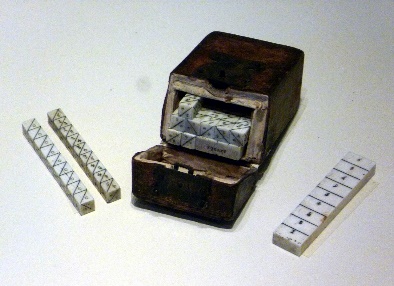
An ivory set of “Napier’s Bones,” an early calculating device invented by John Napier (Source: Wikimedia)
Physics and Mathematics
In the 16th and 17th centuries, European scientists began increasingly applying quantitative measurements to the measurement of physical phenomena on the earth, which translated into the rapid development of mathematics and physics.
Under the scientific method that was defined and applied in the 17th century, natural and artificial circumstances were abandoned, and a research tradition of systematic experimentation was slowly accepted throughout the scientific community. The philosophy of using an inductive approach to nature—to abandon assumption and to attempt to simply observe with an open mind—was in strict contrast with the earlier, Aristotelian approach of deduction, by which analysis of known facts produced further understanding. That principle was particularly true for mathematics and physics. René Descartes, whose thought emphasized the power of reasoning but also helped establish the scientific method, distinguished between the knowledge that could be attained by reason alone (rationalist approach), which he thought was mathematics, and the knowledge that required experience of the world, which he thought was physics.
Mathematization
To the extent that medieval natural philosophers used mathematical problems, they limited social studies to theoretical analyses of local speed and other aspects of life. The actual measurement of a physical quantity, and the comparison of that measurement to a value computed on the basis of theory, was largely limited to the mathematical disciplines of astronomy and optics in Europe. In the 16th and 17th centuries, European scientists began increasingly applying quantitative measurements to the measurement of physical phenomena on Earth.
Galileo Galilei (1564-1642) improved the telescope, with which he made several important astronomical discoveries, including the four largest moons of Jupiter, the phases of Venus, and the rings of Saturn, and made detailed observations of sunspots. He developed the laws for falling bodies based on pioneering quantitative experiments, which he analyzed mathematically.
Galileo was one of the first modern thinkers to clearly state that the laws of nature are mathematical. In broader terms, his work marked another step towards the eventual separation of science from both philosophy and religion, a major development in human thought. Galileo showed a remarkably modern appreciation for the proper relationship between mathematics, theoretical physics, and experimental physics.
|
|
IN THEIR OWN WORDS |
|
Galileo expressed the importance of mathematics in these words in his book The Assayer published in 1623: Philosophy [i.e., physics] is written in this grand book—I mean the universe—which stands continually open to our gaze, but it cannot be understood unless one first learns to comprehend the language and interpret the characters in which it is written. It is written in the language of mathematics, and its characters are triangles, circles, and other geometrical figures, without which it is humanly impossible to understand a single word of it; without these, one is wandering around in a dark labyrinth. |
|
Newton’s Principia formulated the laws of motion and universal gravitation, which dominated scientists’ view of the physical universe for the next three centuries. By deriving Kepler’s laws of planetary motion from his mathematical description of gravity, and then using the same principles to account for the trajectories of comets, the tides, the precession of the equinoxes, and other phenomena, Newton removed the last doubts about the validity of the model of the universe that placed the sun (and not the earth) at the center. This work also demonstrated that the motion of objects on Earth, and of celestial bodies, could be described by the same principles. His laws of motion were to be the solid foundation of mechanics; his law of universal gravitation combined terrestrial and celestial mechanics into one great system that seemed to be able to describe the whole world in mathematical formulae. Newton also developed the theory of gravitation.
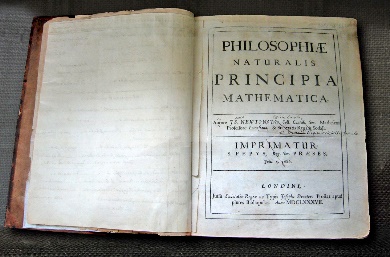
The title page of an early copy of Newton’s Principia. (Source: Wikimedia)
The scientific revolution also witnessed the development of modern optics. Johannes Kepler published Astronomiae Pars Optica (The Optical Part of Astronomy) in 1604. In it, he described the inverse-square law governing the intensity of light, reflection by flat and curved mirrors, and principles of pinhole cameras, as well as the astronomical implications of optics, such a parallax and the apparent sizes of heavenly bodies. Willebrord Snellius found the mathematical law of refraction, now known as Snell’s law, in 1621. Subsequently, Descartes showed, by using geometric construction and the law of refraction (also known as Descartes’ law), that the angular radius of a rainbow is 42°. He also independently discovered the law of reflection. Finally, Newton investigated the refraction of light, demonstrating that a prism could decompose white light into a spectrum of colors, and that a lens and a second prism could recompose the multicolored spectrum into white light. He also showed that the colored light does not change its properties by separating out a colored beam and shining it on various objects.
Dr. William Gilbert, in De Magnete, invented the New Latin word electricus from elektron, the Greek word for “amber.” Gilbert undertook a number of careful electrical experiments, in the course of which he discovered that many substances were capable of manifesting electrical properties. He also discovered that a heated body lost its electricity, and that moisture prevented the electrification of all bodies, due to the fact that moisture impaired the insulation of such bodies. He also noticed that electrified substances attracted all other substances indiscriminately, whereas a magnet only attracted iron. The many discoveries of this nature earned for Gilbert the title of “founder of the electrical science.”
Robert Boyle also worked frequently at the new science of electricity and added several substances to Gilbert’s list of electrics. In 1675, he stated that electric attraction and repulsion can act across a vacuum. One of his important discoveries was that electrified bodies in a vacuum would attract light substances, this indicating that the electrical effect did not depend upon the air as a medium. He also added resin to the then known list of electrics. By the end of the 17th Century, researchers had developed practical means of generating electricity by friction with an an electrostatic generator, but the development of electrostatic machines did not begin in earnest until the 18th century, when they became fundamental instruments in the studies about the new science of electricity. The first usage of the word electricity is ascribed to Thomas Browne in 1646 work. In 1729, Stephen Gray demonstrated that electricity could be “transmitted” through metal filaments.
Astronomy
Though astronomy is the oldest of the natural sciences, its development during the scientific revolution entirely transformed societal views about nature by moving from geocentrism (the idea that the earth is the center of the universe) to heliocentrism (the idea that the sun is the center of the universe).
The Emergence of Modern Astronomy
While astronomy is the oldest of the natural sciences, dating back to antiquity, its development during the period of the scientific revolution entirely transformed the views of society about nature. As we have already seen, the publication Nicolaus Copernicus ‘ De revolutionibus orbium coelestium (On the Revolutions of the Heavenly Spheres) published in 1543, is, in fact, often seen as marking the beginning of the time when scientific disciplines, including astronomy, began to apply modern empirical research methods, and gradually transformed into the modern sciences as we know them today.
Copernican heliocentrism is the name given to the astronomical model developed by Nicolaus Copernicus and published in 1543. It positioned the sun near the center of the universe, motionless, with Earth and the other planets rotating around it in circular paths, modified by epicycles and at uniform speeds. The Copernican model departed from the Ptolemaic system that prevailed in western culture for centuries, placing Earth at the center of the universe. Copernicus’ De revolutionibus marks the beginning of the shift away from a geocentric (and anthropocentric) universe with Earth at its center. Copernicus held that Earth is another planet revolving around the fixed sun once a year and turning on its axis once a day. But while he put the sun at the center of the celestial spheres, he did not put it at the exact center of the universe, but near it. His system used only uniform circular motions, correcting what was seen by many as the chief inelegance in Ptolemy’s system.
Johannes Kepler
Johannes Kepler was a German scientist. In 1596, he published his first book, the Mysterium cosmographicum, which was the first to openly endorse Copernican cosmology by an astronomer since the 1540s. The book described his model that used Pythagorean mathematics and the five Platonic solids to explain the number of planets, their proportions, and their order.
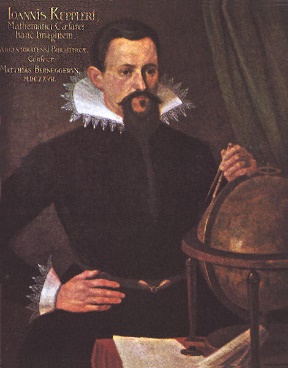
A portrait of Johannes Kepler (Source: Wikimedia)
In 1600, Kepler set to work on the orbit of Mars, the second most eccentric of the six planets known at that time. This work was the basis of his next book, the Astronomia nova (1609). The book argued heliocentrism and ellipses for planetary orbits, instead of circles modified by epicycles. It contains the first two of his eponymous three laws of planetary motion (in 1619, the third law was published). The laws state the following:
- All planets move in elliptical orbits, with the sun at one focus.
- A line that connects a planet to the sun sweeps out equal areas in equal times.
- The time required for a planet to orbit the sun, called its period, is proportional to long axis of the ellipse raised to the 3/2 power. The constant of proportionality is the same for all the planets.
Galileo Galilei
Galileo Galilei was an Italian scientist who is sometimes referred to as the “father of modern observational astronomy.” Based on the designs of Hans Lippershey, he designed his own telescope, which he had improved to 30x magnification. Using this new instrument, Galileo made a number of astronomical observations, which he published in the Sidereus Nuncius in 1610. In this book, he described the surface of the moon as rough, uneven, and imperfect. His observations challenged Aristotle ’s claim that the moon was a perfect sphere, and the larger idea that the heavens were perfect and unchanging. While observing Jupiter over the course of several days, Galileo noticed four stars close to Jupiter whose positions were changing in a way that would be impossible if they were fixed stars. After much observation, he concluded these four stars were orbiting the planet Jupiter and were in fact moons, not stars. This was a radical discovery because, according to Aristotelian cosmology, all heavenly bodies revolve around Earth, and a planet with moons obviously contradicted that popular belief. While contradicting Aristotelian belief, it supported Copernican cosmology, which stated that Earth is a planet like all others.

On this page, Galileo first noted the moons of Jupiter. (Source: Wikimedia)
In 1610, Galileo also observed that Venus had a full set of phases, similar to the phases of the moon, that we can observe from Earth. This was explainable by the Copernican system, which said that all phases of Venus would be visible due to the nature of its orbit around the sun, unlike the Ptolemaic system, which stated only some of Venus’s phases would be visible. Due to Galileo’s observations of Venus, Ptolemy’s system became highly suspect, and the majority of leading astronomers subsequently converted to various heliocentric models, making his discovery one of the most influential in the transition from geocentrism to heliocentrism.
Uniting Astronomy and Physics: Isaac Newton
Isaac Newton developed further ties between physics and astronomy through his law of universal gravitation. Realizing that the same force that attracted objects to the surface of Earth held the moon in orbit around the Earth, Newton was able to explain, in one theoretical framework, all known gravitational phenomena. Newton’s Principia (1687) formulated the laws of motion and universal gravitation, which dominated scientists’ view of the physical universe for the next three centuries. By deriving Kepler’s laws of planetary motion from his mathematical description of gravity, and then using the same principles to account for the trajectories of comets, the tides, the precession of the equinoxes, and other phenomena, Newton removed the last doubts about the validity of the heliocentric model of the cosmos. This work also demonstrated that the motion of objects on Earth and of celestial bodies could be described by the same principles. His laws of motion were to be the solid foundation of mechanics; his law of universal gravitation combined terrestrial and celestial mechanics into one great system that seemed to be able to describe the whole world in mathematical formulae.
Medicine
The Renaissance had brought an intense focus on varied scholarship to Europe in the 15th century. A major effort to translate the Arabic and Greek scientific works into Latin emerged, and Europeans gradually became experts not only in the ancient writings of the Romans and Greeks, but also in the contemporary writings of Islamic scientists. During the 16th and 17th centuries, experimental investigation, particularly in the field of dissection and body examination, advanced the knowledge of human anatomy. Other developments of the period also contributed to the modernization of medical research, including printed books that allowed for a wider distribution of medical ideas and anatomical diagrams, more open attitudes of Renaissance humanism, and the Church’s diminishing impact on the teachings of the medical profession and universities. In addition, the invention and popularization of microscope in the 17th century greatly advanced medical research.
Human Anatomy
The writings of ancient Roman physician Galen had dominated European thinking in medicine. Galen’s understanding of anatomy and medicine was principally influenced by the then-current theory of humorism (also known as the four humors: black bile, yellow bile, blood, and phlegm), as advanced by ancient Greek physicians, such as Hippocrates. His theories dominated and influenced western medical science for more than 1,300 years. His anatomical reports, based mainly on dissection of monkeys and pigs, remained uncontested until 1543, when printed descriptions and illustrations of human dissections were published in the seminal work De humani corporis fabrica by Andreas Vesalius, who first demonstrated the mistakes in the Galenic model. His anatomical teachings were based upon the dissection of human corpses, rather than the animal dissections that Galen had used as a guide. Vesalius’ work emphasized the priority of dissection and what has come to be called the “anatomical” view of the body, seeing human internal functioning as an essentially corporeal structure filled with organs arranged in three-dimensional space. This was in stark contrast to many of the anatomical models used previously.
Further groundbreaking work was carried out by William Harvey, who published De Motu Cordis in 1628. Harvey made a detailed analysis of the overall structure of the heart, going on to an analysis of the arteries, showing how their pulsation depends upon the contraction of the left ventricle, while the contraction of the right ventricle propels its charge of blood into the pulmonary artery. He noticed that the two ventricles move together almost simultaneously and not independently like had been thought previously by his predecessors. Harvey also estimated the capacity of the heart, how much blood is expelled through each pump of the heart, and the number of times the heart beats in a half an hour. From these estimations, he went on to prove how the blood circulated in a circle through the body.
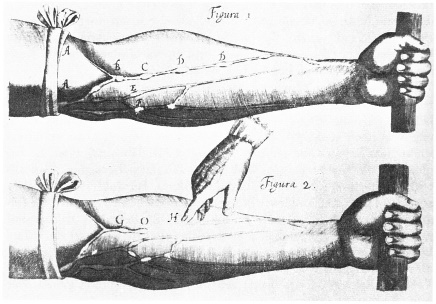
Image of veins from William Harvey’s De Motu Cordis. (Source: Wikimedia)
Other Medical Advances
Various other advances in medical understanding and practice were made. French surgeon Ambroise Paré (c. 1510-1590) is considered one of the fathers of surgery and modern forensic pathology, and a pioneer in surgical techniques and battlefield medicine, especially in the treatment of wounds. He was also an anatomist who invented several surgical instruments and was part of the Parisian Barber Surgeon guild. Paré was also an important figure in the progress of obstetrics in the middle of the 16th century.
Herman Boerhaave (1668-1738), a Dutch botanist, chemist, Christian humanist and physician of European fame, is regarded as the founder of clinical teaching and of the modern academic hospital. He is sometimes referred to as “the father of physiology,” along with the Venetian physician Santorio Santorio (1561-1636), who introduced the quantitative approach into medicine, and with his pupil Albrecht von Haller (1708-1777). He is best known for demonstrating the relation of symptoms to lesions and, in addition, he was the first to isolate the chemical urea from urine. He was the first physician that put thermometer measurements to clinical practice.
Bacteria and protists were first observed with a microscope by Antonie van Leeuwenhoek in 1676, initiating the scientific field of microbiology.
French physician Pierre Fauchard started dentistry science as we know it today, and he has been named “the father of modern dentistry.” He is widely known for writing the first complete scientific description of dentistry, Le Chirurgien Dentiste (“The Surgeon Dentist”), published in 1728. The book described basic oral anatomy and function, signs and symptoms of oral pathology, operative methods for removing decay and restoring teeth, periodontal disease (pyorrhea), orthodontics, replacement of missing teeth, and tooth transplantation.
